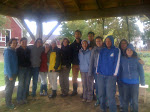Today, the sun was shining again.
 |
Emma, learning to bore
|
Returning to the greenhouse, much work was accomplished on the timber frame project. I was happy to welcome Emma and Nick for a visit; especially happy because they worked on two mortises while I finished the top tenon.
 |
| Emma, chiseling |
 |
| Emma and Nick cleaning out a mortise |
 |
| Nick, boring. |
On returning to the farm, we saw the first of the two new barn doors being installed. It is beautiful!
 |
| The team putting up the first door |
Our afternoon session was with Nate and our new grower Steven. We continued on with our case studies of vegetable crops. We brainstormed the parameters of a growing season and then set about to figuring out how to decide when a crop ought to be sowed (either in the greenhouse or directly into the soil). We had to keep in mind the following: the market (don't give butternut squash in August), when the soil is ready (dry enough, warm enough, how long the growing process takes, how much is in the green house, the harvest window, when the first frost and last frost fall and how to balance out all the work throughout the season, . Here is my example:

I want to put a nice healthy head of bok choy in the CSA box each week, for twenty weeks, starting on June 1. I need to plant new bok choy seeds in the greenhouse starting March 15 through July 29. Bok Choy is a hardy plant that can go out before the last frost, so starting mid-April, I plant my first batch of transplants and harvest on June 1 to deliver that day! And each week, more bok choy will be harvesting until the last frost in September. That's a lot of bok choy. Nate let us in on a grower's little secret. You can purchase seeds from different varieties of a vegetable that ripen at different times. The work process is the same but instead of planting one week's worth of one kind of seed, one would plant two week's worth of two seeds--one of a quicker ripening and one of a later ripening. Then, you have two harvests for the time spent planting out.







Oh, now that's not nice. You shouldn't call Emma's friend boring! :-)
ReplyDeleteHa! When we first starting using it, we walked around saying "Are you done with that "exciting machine" yet?"
ReplyDelete